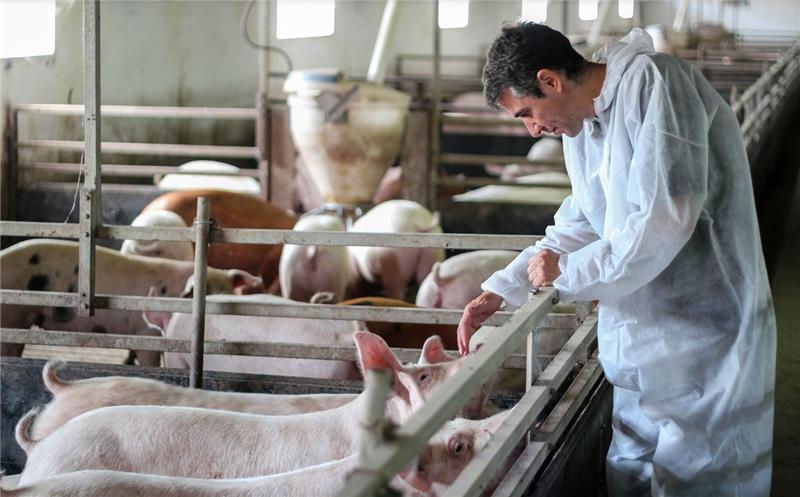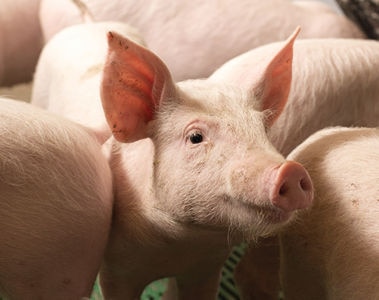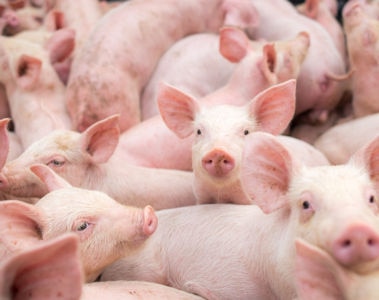Ensuring a positive energy balance during the previous lactation is also important for ovulation, as a negative energy balance significantly reduces follicle size8.
Other factors that influence sow health and reproductive success
Apart from the nutrient composition of the diet, other important factors that contribute towards sow health and reproductive success include:
- Prevention of exposure to mycotoxins – Mycotoxins (DON and BEA) impair cell development including oocyte development and gilt oocytes are more sensitive to this effect than sows9.
- Avoidance of urinary tract infections (UTI) – 20 to 40% of EU sows affected by subclinical UTI and sows without UTI infection perform better (fewer still births, shorter farrowing time).
Dietary tools for supporting muscle development in pigs in-utero
Muscle myogenesis starts from d 35 of gestation and the number of muscle fibres in a piglet is fixed at birth. Precise quantitative and qualitative nutrition during gestation is therefore critical for maximizing piglet muscle deposition both before and after birth.
Feed allowance
One approach to help achieve this is careful regulation of the sow feed allowance, because this has a direct effect on the number of muscle fibres that are formed. This is particularly important during d 25 to 45 of gestation when primary muscle fibres are developing; if gestation feed is reduced from 3 kg to 2.2 kg/sow/day during this period, the number and size of muscle fibres is reduced10.
Vitamin D supplementation
Vitamin D supplementation is another dietary tool for supporting muscle development of piglets in utero and after birth.
Supplemental vitamin D3 given to sows in the form of 25(OH)D3 (as Hy-D®) has been shown to interact with both foetal and developing piglet tissues. This form of vitamin D is transferred more efficiently from feed to blood than classical vitamin D3 and results in:
- Improved placental development in gestating sows11
- Increased foetal plasma levels of 25(OH)D3
- Increased number of muscle fibres in the foetus and piglets11
- Increased serum bone turnover and bone quality
- Increased production of beneficial gut bacteria metabolites (butyrate) in piglets
Other vitamins
It is also important to pay heed to the adequacy of other vitamins in sow gestation diets.
Levels of vitamin C (ascorbic acid) as well as those of vitamin E (α-tocopherol) and vitamin A (retinol) drop at the end of gestation12 as the rapid growth requirements of the developing litter create conditions of oxidative stress and drain sow vitamin storage reserves. Diet composition needs to be carefully analysed and monitored towards the end of gestation to ensure these micronutrients do not become deficient.
And finally…the importance of physical checks on sows
The increased nutrient requirements of the developing litter towards the end of gestation mean that there is a risk of sows arriving at farrowing in a catabolic status (where fat and muscle mass is being lost rather than gained).
Sows in a catabolic status have impaired litter characteristics at birth (lower birth weight and higher litter heterogeneity): A loss of 5 mm of muscle depth at the end of gestation (d 84 to 105) results in a drop in average birth weight of 100 g in small piglets and 1.27 kg in litter birth weight, and an increase in litter heterogeneity (+3%)13.
Backfat depth is also important. It has been shown that as long as sows have 17 to 18 mm fat at d 85 of gestation, a subsequent loss in muscle mass can improve piglet weight and litter homogeneity at birth, whereas when sows have less than 17 to 18 mm fat, a subsequent loss in muscle mass is detrimental to piglet birth weight and heterogeneity at birth.
Physical checks on sow muscle thickness and fat depth, using available on-farm technologies, can provide useful insights into the nutritional adequacy of the gestation diet.
Conclusions
Gestation is a complex period involving dynamic requirements for nutrients by sows and their developing piglets. Ensuring the diet is nutritionally adequate so that sows arrive at farrowing with adequate reserves of energy and muscle mass, bearing piglets that are uniform in size and not growth-restricted, requires careful formulation and monitoring. Supplementation of vitamin D3 as 25-OH-D3 can be effective in supporting sow and foetal/piglet growth and development.



